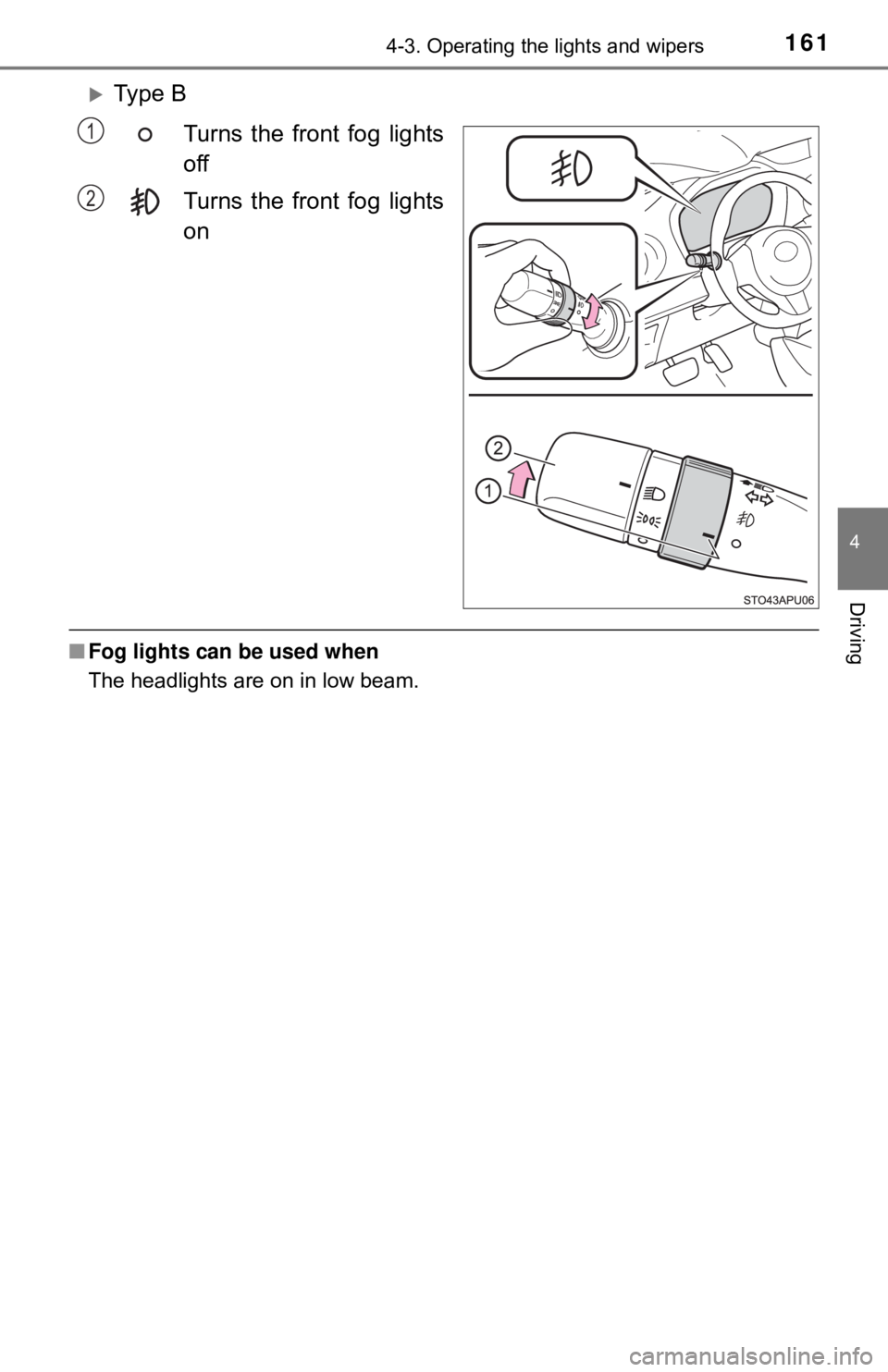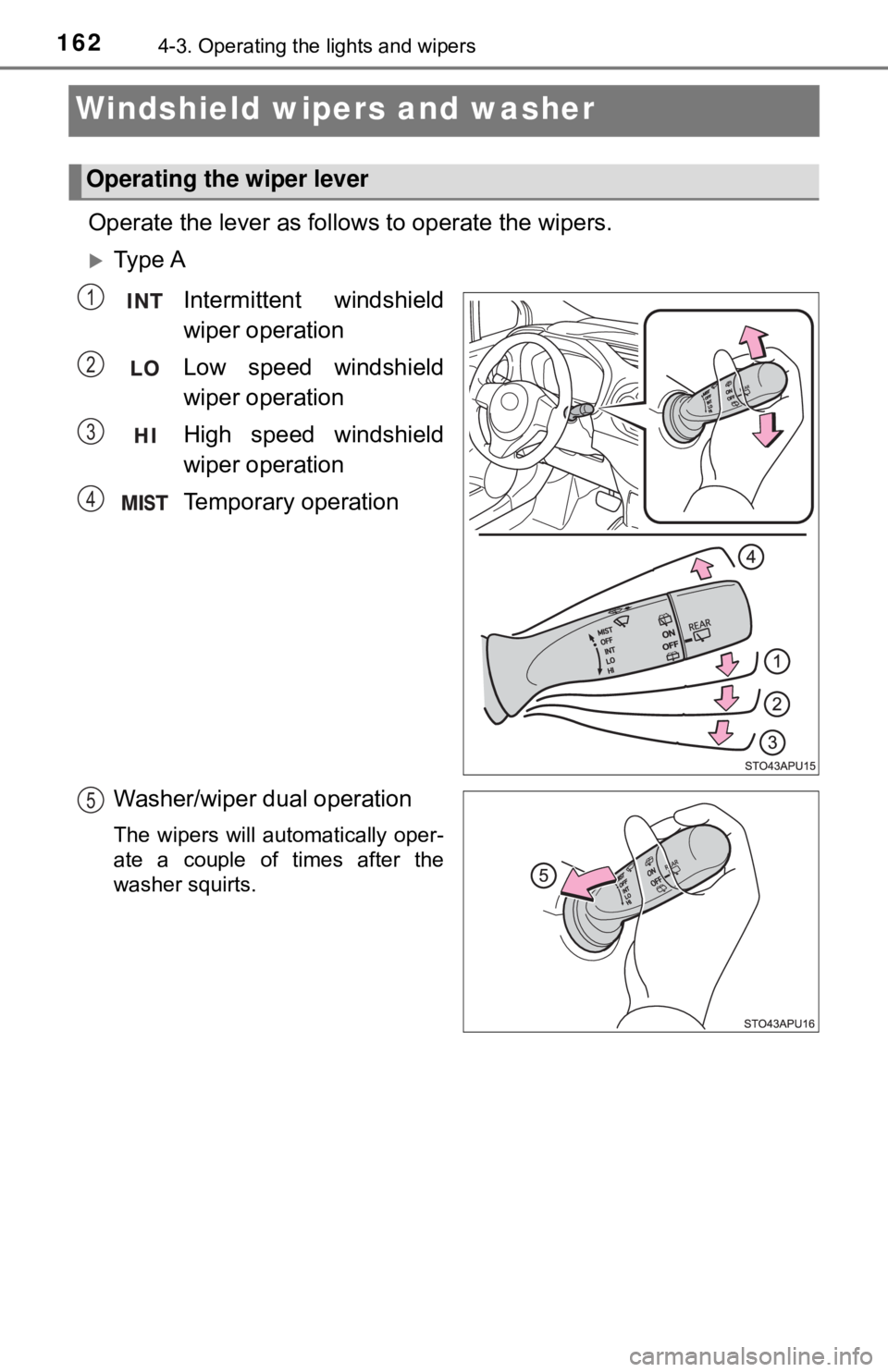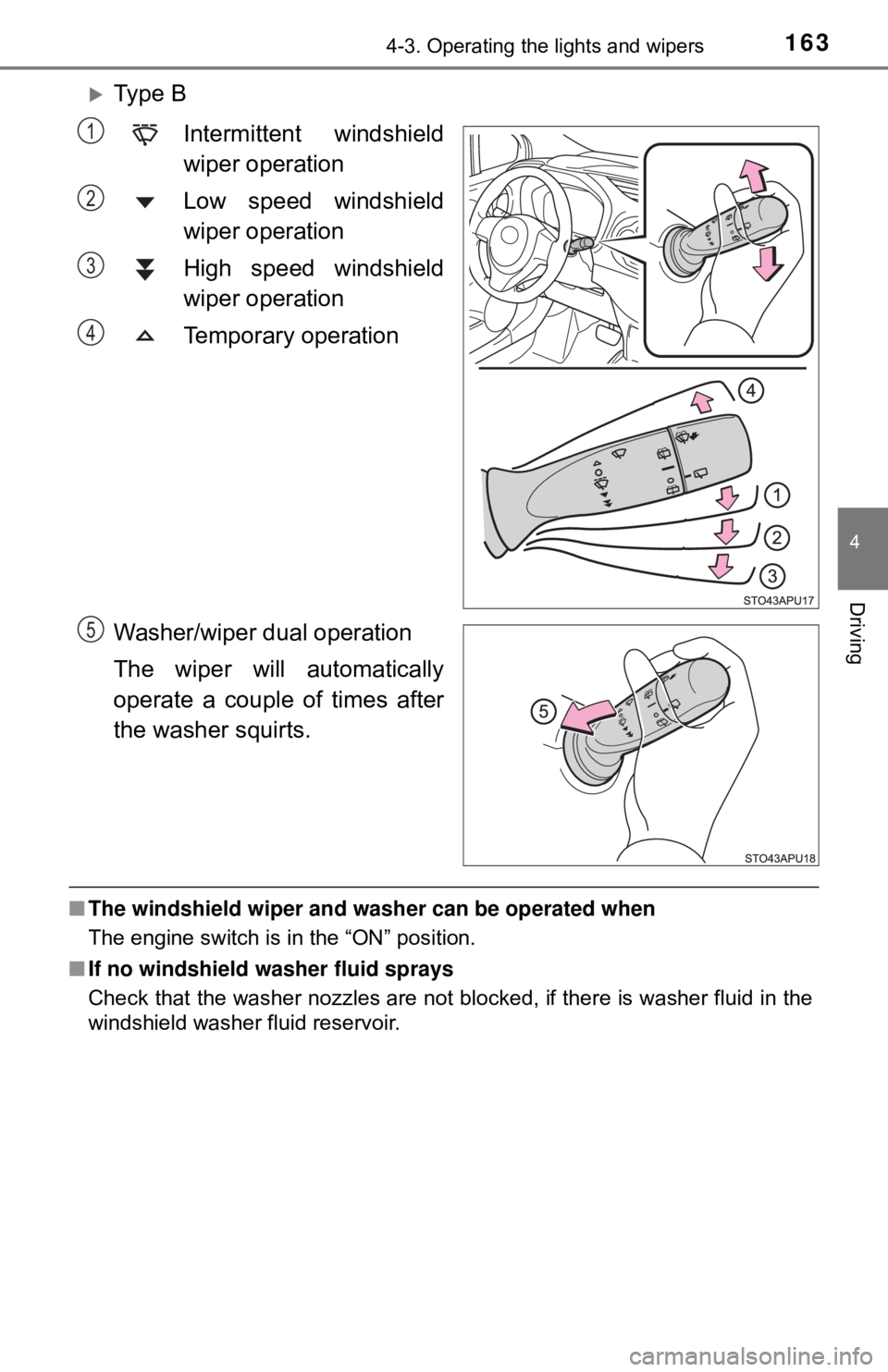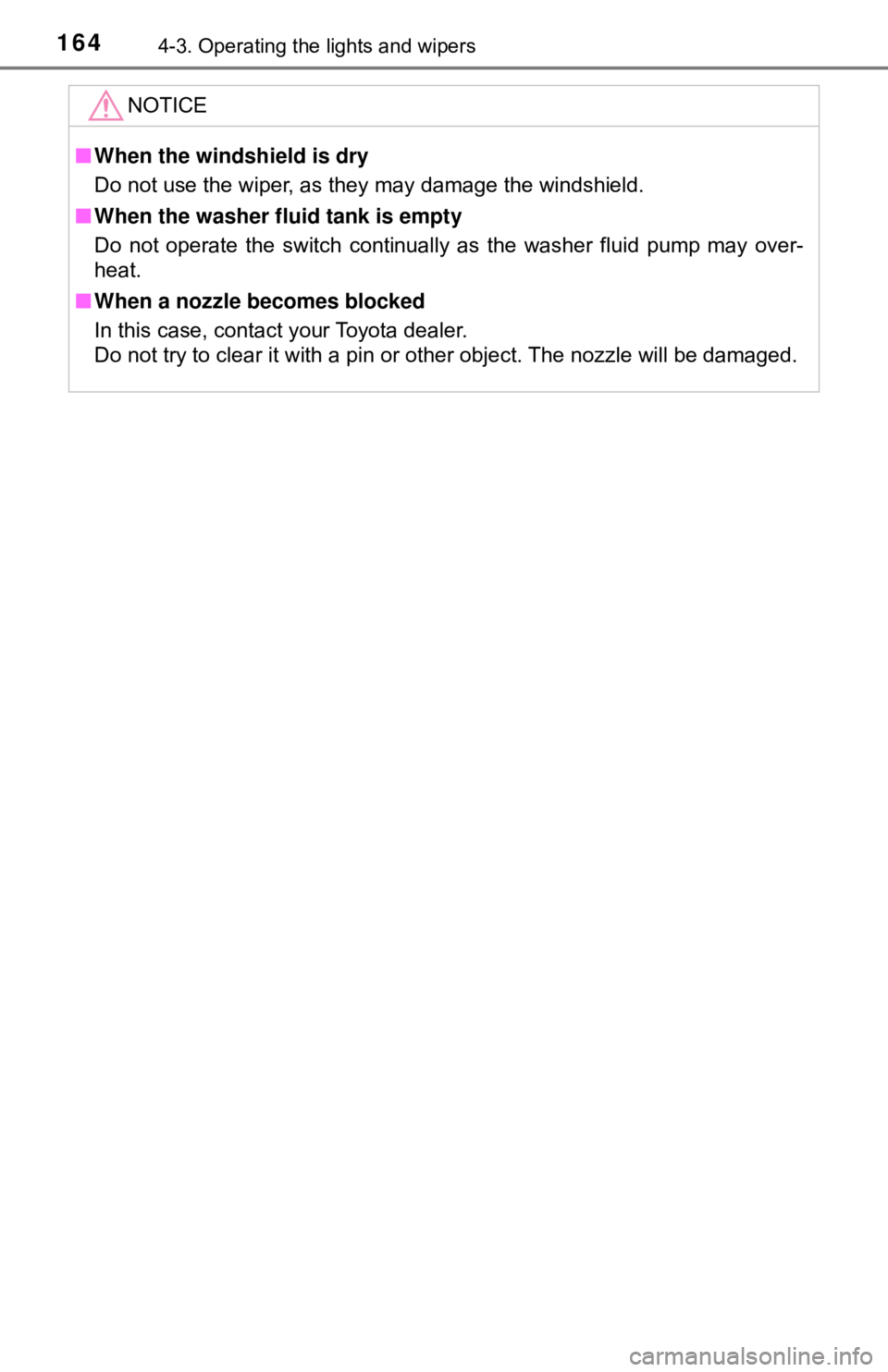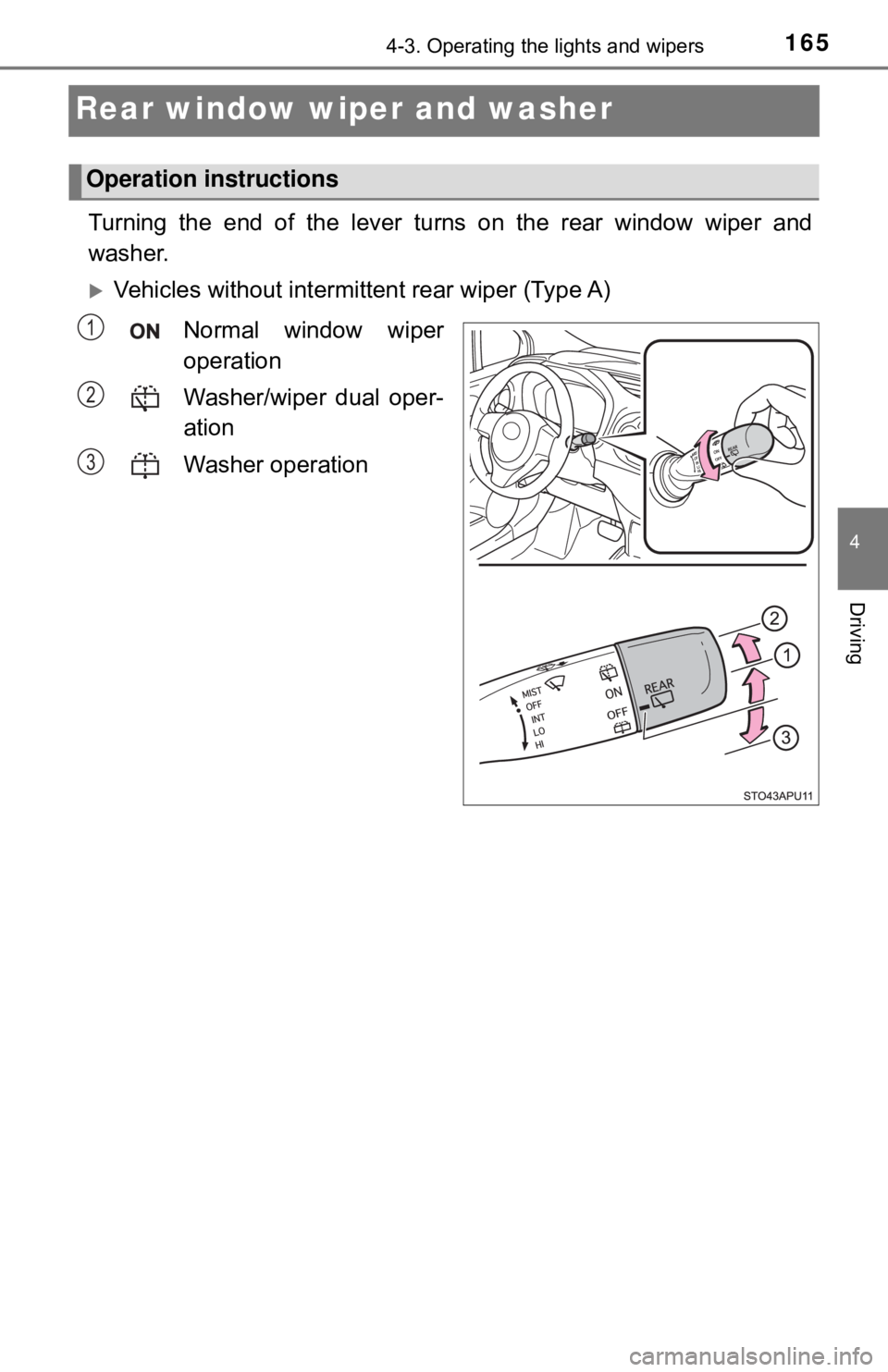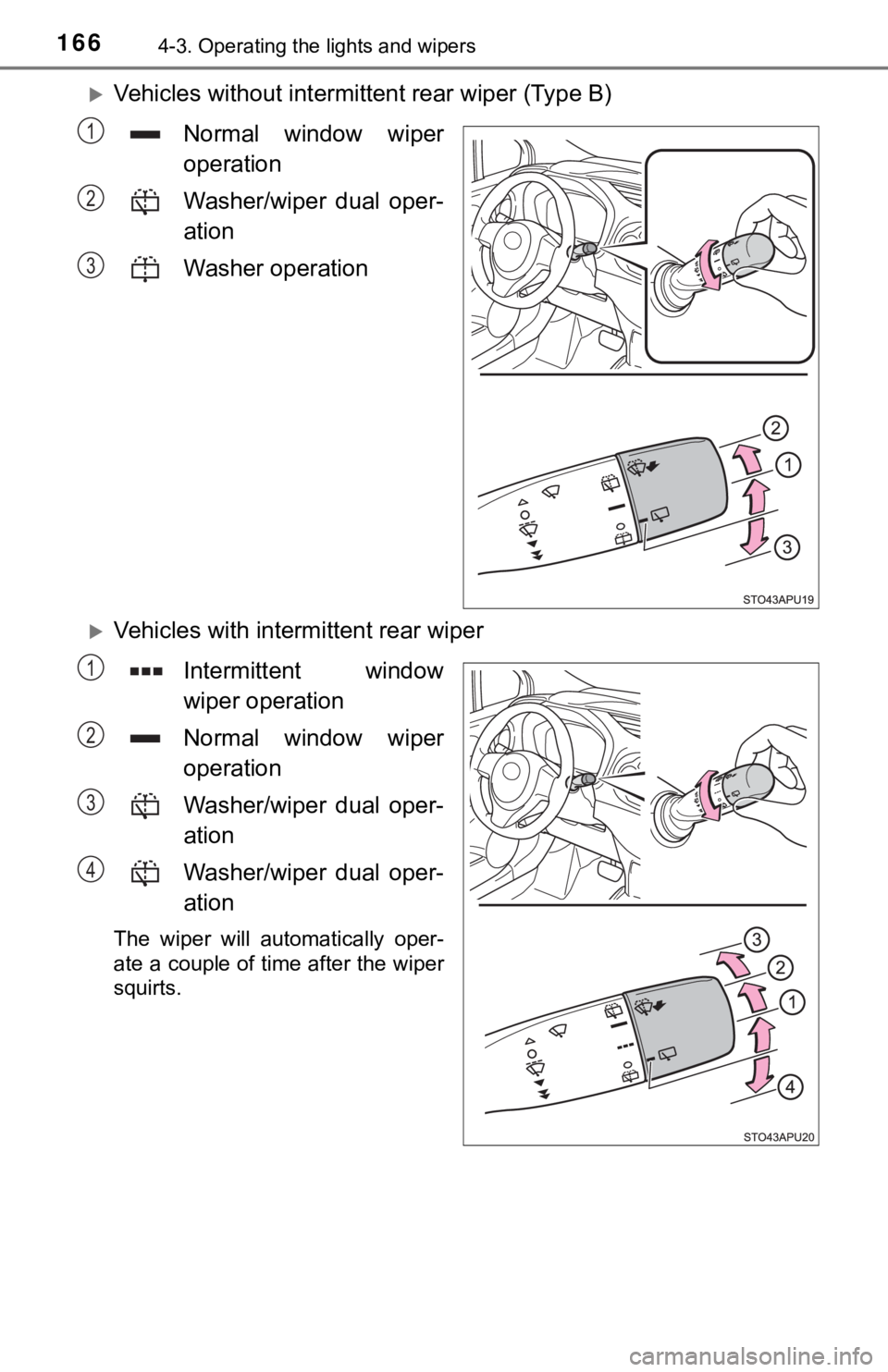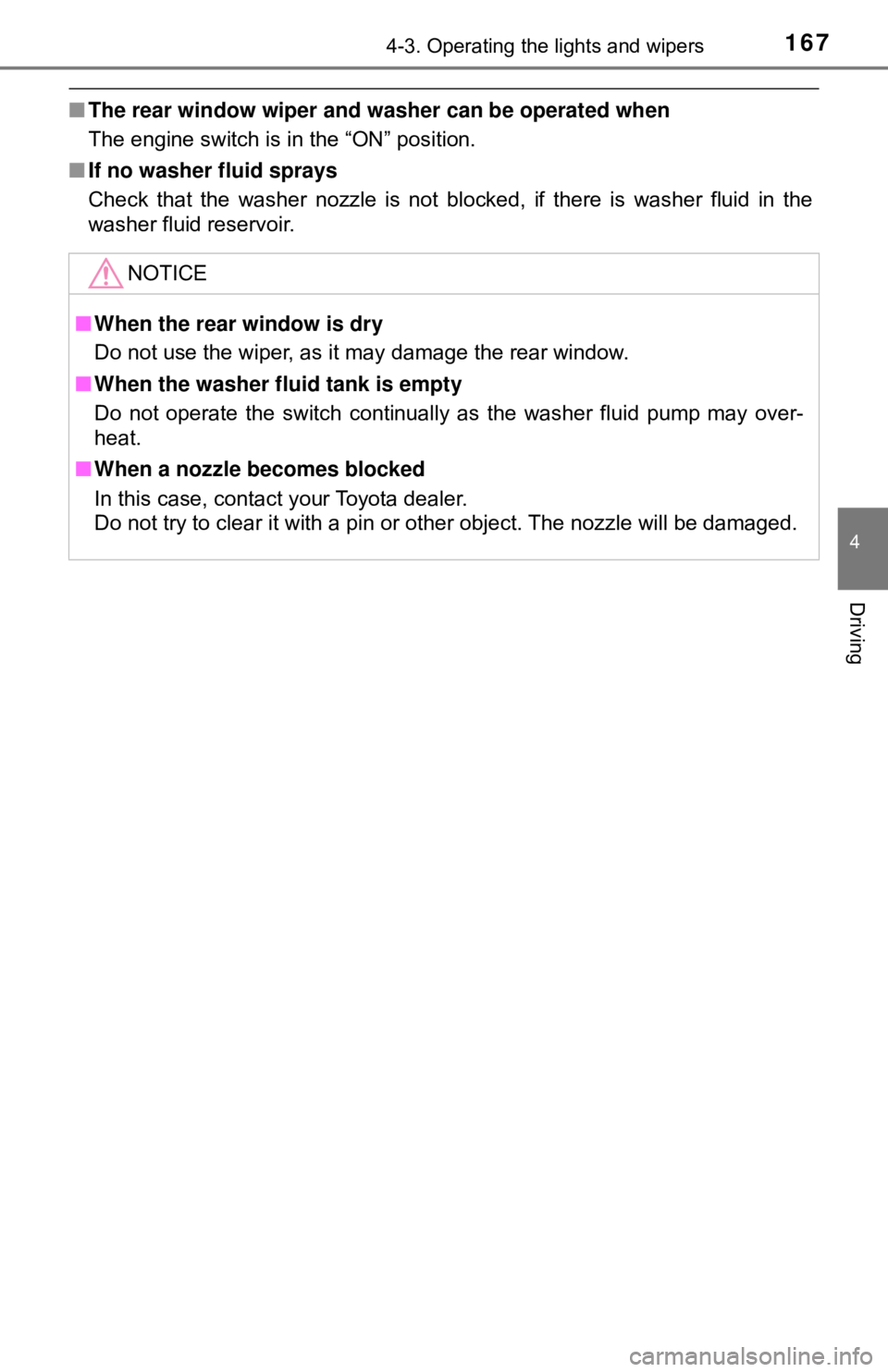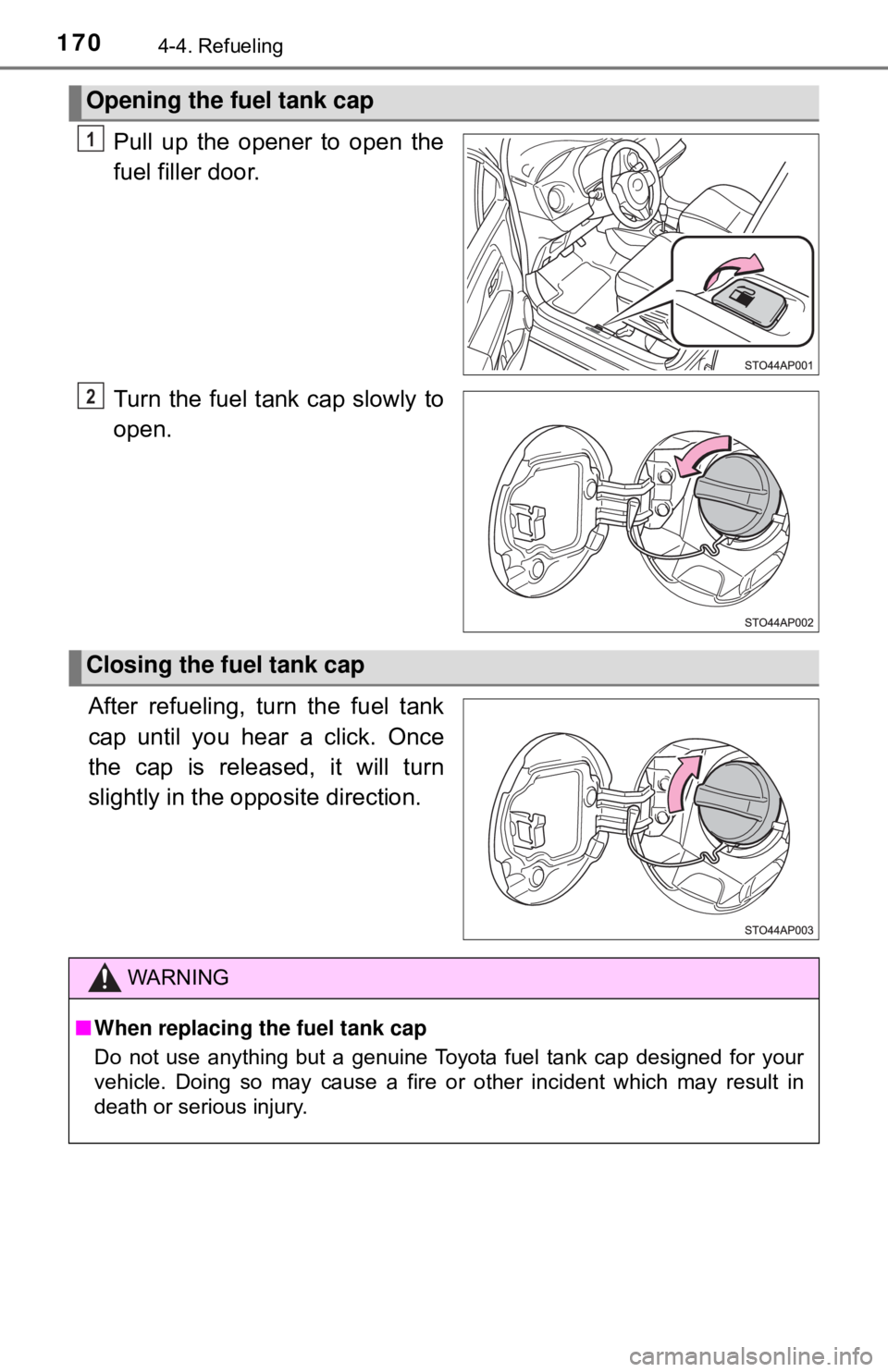TOYOTA YARIS LIFTBACK 2020 Owners Manual (in English)
YARIS LIFTBACK 2020
TOYOTA
TOYOTA
https://www.carmanualsonline.info/img/14/43158/w960_43158-0.png
TOYOTA YARIS LIFTBACK 2020 Owners Manual (in English)
Trending: glove box, headlight bulb, seat memory, radiator, check transmission fluid, run flat, phone
Page 161 of 520
1614-3. Operating the lights and wipers
4
Driving
Ty p e BTurns the front fog lights
off
Turns the front fog lights
on
■Fog lights can be used when
The headlights are on in low beam.
1
2
Page 162 of 520
1624-3. Operating the lights and wipers
Windshield wipers and washer
Operate the lever as follows to operate the wipers.
Ty p e AIntermittent windshield
wiper operation
Low speed windshield
wiper operation
High speed windshield
wiper operation
Temporary operation
Washer/wiper dual operation
The wipers will automatically oper-
ate a couple of times after the
washer squirts.
Operating the wiper lever
1
2
3
4
5
Page 163 of 520
1634-3. Operating the lights and wipers
4
Driving
Ty p e BIntermittent windshield
wiper operation
Low speed windshield
wiper operation
High speed windshield
wiper operation
Temporary operation
Washer/wiper dual operation
The wiper will automatically
operate a couple of times after
the washer squirts.
■ The windshield wiper and washer can be operated when
The engine switch is in the “ON” position.
■ If no windshield washer fluid sprays
Check that the washer nozzles are not blocked, if there is washer fluid in the
windshield washer fluid reservoir.
1
2
3
4
5
Page 164 of 520
1644-3. Operating the lights and wipers
NOTICE
■When the windshield is dry
Do not use the wiper, as they may damage the windshield.
■ When the washer fluid tank is empty
Do not operate the switch continually as the washer fluid pump may over-
heat.
■ When a nozzle becomes blocked
In this case, contact your Toyota dealer.
Do not try to clear it with a pin or other object. The nozzle will be damaged.
Page 165 of 520
1654-3. Operating the lights and wipers
4
Driving
Rear window wiper and washer
Turning the end of the lever turns on the rear window wiper and
washer.
Vehicles without intermittent rear wiper (Type A)
Normal window wiper
operation
Washer/wiper dual oper-
ation
Washer operation
Operation instructions
1
2
3
Page 166 of 520
1664-3. Operating the lights and wipers
Vehicles without intermittent rear wiper (Type B)
Normal window wiper
operation
Washer/wiper dual oper-
ation
Washer operation
Vehicles with intermittent rear wiper Intermittent window
wiper operation
Normal window wiper
operation
Washer/wiper dual oper-
ation
Washer/wiper dual oper-
ation
The wiper will automatically oper-
ate a couple of time after the wiper
squirts.
1
2
3
1
2
3
4
Page 167 of 520
1674-3. Operating the lights and wipers
4
Driving
■The rear window wiper and w asher can be operated when
The engine switch is in the “ON” position.
■ If no washer fluid sprays
Check that the washer nozzle is not blocked, if there is washer fluid in the
washer fluid reservoir.
NOTICE
■When the rear window is dry
Do not use the wiper, as it may damage the rear window.
■ When the washer fluid tank is empty
Do not operate the switch continually as the washer fluid pump may over-
heat.
■ When a nozzle becomes blocked
In this case, contact your Toyota dealer.
Do not try to clear it with a pin or other object. The nozzle will be damaged.
Page 168 of 520
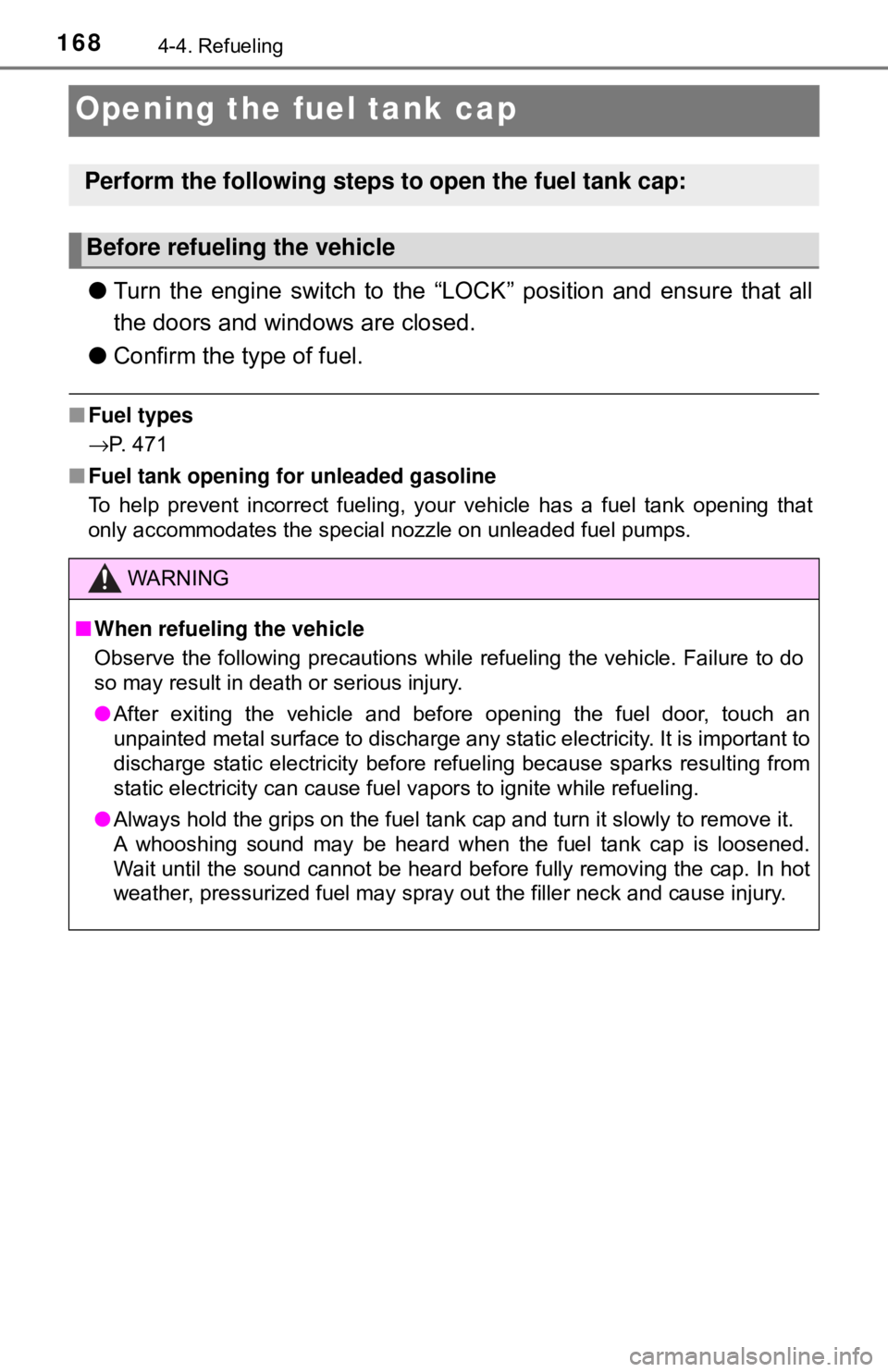
1684-4. Refueling
Opening the fuel tank cap
●Turn the engine switch to the “LOC K” position and ensure that all
the doors and windows are closed.
● Confirm the type of fuel.
■Fuel types
→P. 471
■ Fuel tank opening for unleaded gasoline
To help prevent incorrect fueling, y our vehicle has a fuel tank opening that
only accommodates the special nozzle on unleaded fuel pumps.
Perform the following steps to open the fuel tank cap:
Before refueling the vehicle
WARNING
■ When refueling the vehicle
Observe the following precautions while refueling the vehicle. Failure to do
so may result in death or serious injury.
● After exiting the vehicle and before opening the fuel door, touch an
unpainted metal surface to discharge any static electricity. It is important to
discharge static electricity before refueling because sparks resulting from
static electricity can cause fuel vapors to ignite while refueling.
● Always hold the grips on the fuel tank cap and turn it slowly to remove it.
A whooshing sound may be heard when the fuel tank cap is loosened.
Wait until the sound cannot be heard before fully removing the cap. In hot
weather, pressurized fuel may spray out the filler neck and cause injury.
Page 169 of 520
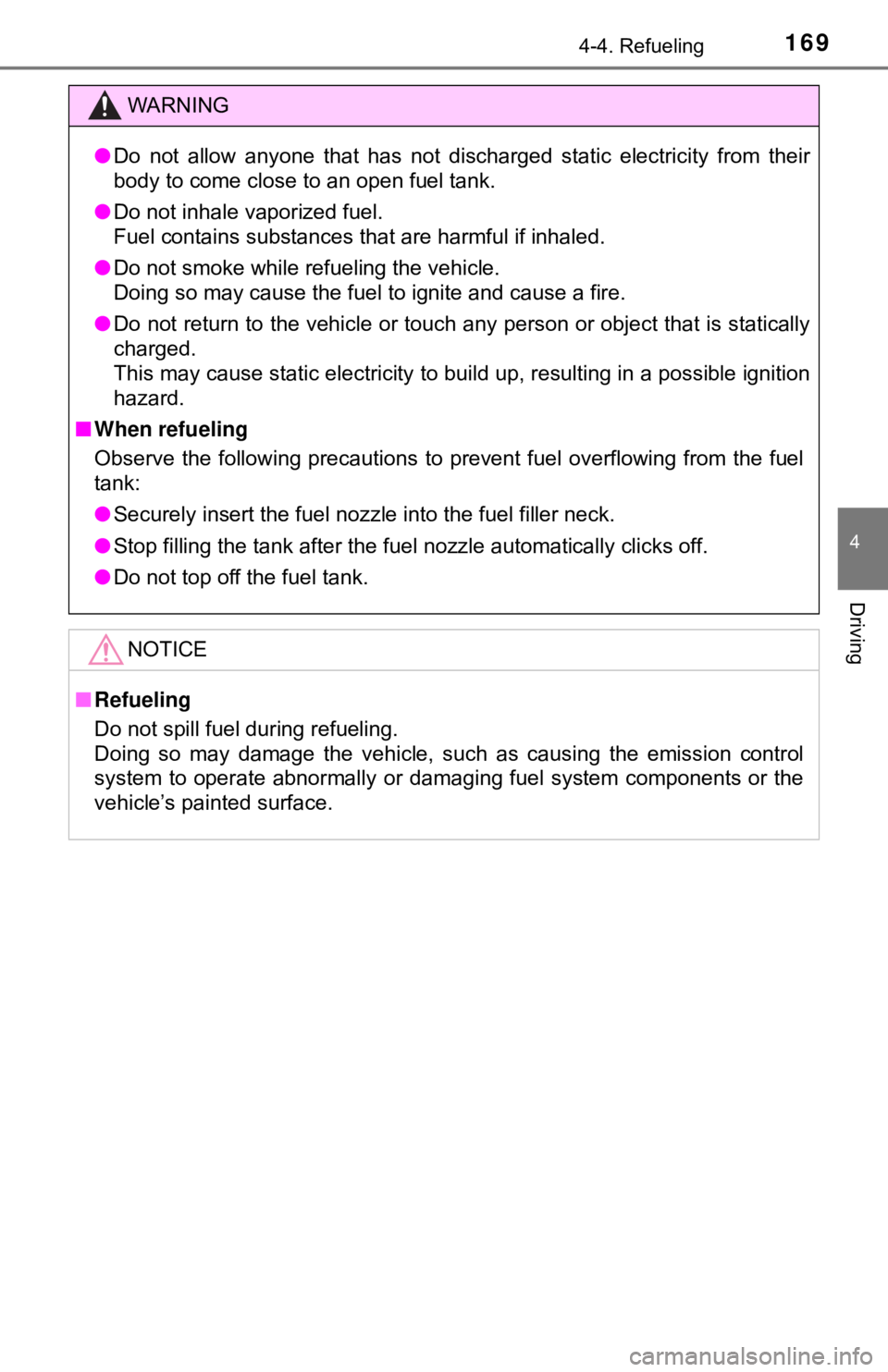
1694-4. Refueling
4
Driving
WARNING
●Do not allow anyone that has not discharged static electricity from their
body to come close to an open fuel tank.
● Do not inhale vaporized fuel.
Fuel contains substances that are harmful if inhaled.
● Do not smoke while refueling the vehicle.
Doing so may cause the fuel to ignite and cause a fire.
● Do not return to the vehicle or touch any person or object that is statically
charged.
This may cause static electricity to build up, resulting in a possible ignition
hazard.
■ When refueling
Observe the following precautions to prevent fuel overflowing from the fuel
tank:
● Securely insert the fuel nozzle into the fuel filler neck.
● Stop filling the tank after the fuel nozzle automatically clicks off.
● Do not top off the fuel tank.
NOTICE
■Refueling
Do not spill fuel during refueling.
Doing so may damage the vehicle, such as causing the emission control
system to operate abnormally or damaging fuel system components or the
vehicle’s painted surface.
Page 170 of 520
1704-4. Refueling
Pull up the opener to open the
fuel filler door.
Turn the fuel tank cap slowly to
open.
After refueling, turn the fuel tank
cap until you hear a click. Once
the cap is released, it will turn
slightly in the opposite direction.
Opening the fuel tank cap
1
2
Closing the fuel tank cap
WARNING
■ When replacing the fuel tank cap
Do not use anything but a genuine Toyota fuel tank cap designed for your
vehicle. Doing so may cause a fire or other incident which may result in
death or serious injury.
Trending: fog light bulb, jump start, service indicator, jump start terminals, change key battery, tires, door lock
